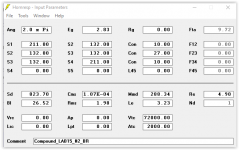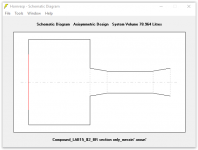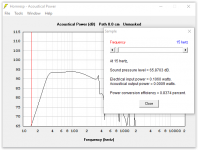this gives me a more clear idea of whats happening..
The reason the lower peak is damped in your example is that the motion reducing action of the port on the diaphragm is applied lower in frequency, reducing cone motion below resonance more. When the motion reduction is applied higher, it reduces the upper peak more. The reason the peaks move closer and further with changes in box volume has to do with the "Q" of the port output.
A complicating factor is damping. Damping applied that restricts port flow damps the lower peak significantly. Damping of the box spring affects the upper peak more. This is why the peaks are sometimes referred to as the port and box peaks in the impedance curve.
Port size, box size, tuning and drive specs are a balancing act. In my experience the final tuning never has an equal hump impedance curve.
1. the ports job is to control the drive at low frequency
2. the box job is to control the driver at frequencies above tuning
3. equal hump impedance curve is valuable to determine the box's affect on driver specs. q and fo will move depending on the load of the box.
When I am looking to design a speaker I look at the q of the alignment I want to use, then look for a driver that closely matches. Keep in mind the advertised specs are and approximation and you still need to measure the driver. I personally like low q drivers they are less forgiving, but when setup right sound tight. Not setup right they sound like crap.
I learned this working with car audio where you have to take the listening volume into account. Because a speaker tuned in a workshop is not even close in a car.
1. the ports job is to control the drive at low frequency
2. the box job is to control the driver at frequencies above tuning
3. equal hump impedance curve is valuable to determine the box's affect on driver specs. q and fo will move depending on the load of the box.
When I am looking to design a speaker I look at the q of the alignment I want to use, then look for a driver that closely matches. Keep in mind the advertised specs are and approximation and you still need to measure the driver. I personally like low q drivers they are less forgiving, but when setup right sound tight. Not setup right they sound like crap.
I learned this working with car audio where you have to take the listening volume into account. Because a speaker tuned in a workshop is not even close in a car.
1. the ports job is to control the drive at low frequency
2. the box job is to control the driver at frequencies above tuning
Have you (and Ron E) ever compared your way of looking at BR boxes to the views of the folks who teach or write textbooks in acoustics*?
B.
*that wouldn't be me, I'm just an amateur DIY guy
Last edited:
...compared your way of looking at BR boxes to the views of the folks who teach or write textbooks in acoustics*?
Have you? Have you written your own simulators using standard electro-mechano-acoustic circuit techniques? Could you ever fathom a time when you could share knowledge without constantly pushing your anti-simulator, anti-bass-reflex agenda and belittling or questioning the credentials or intelligence of those who disagree with you? Sometimes even when they don't?
Have you (and Ron E) ever compared your way of looking at BR boxes to the views of the folks who teach or write textbooks in acoustics*?
B.
*that wouldn't be me, I'm just an amateur DIY guy
The short answer is yes, but you had to know I am going to give the long answer too.
I am also a DIY person, but have spent countless hours reading papers from the ASE and testing those theories. I have tossed more boxes into the trash than I care to think about. A lot of the ideas came from papers written by D.B. Keele Jr., by the way very good reading.
I am now an IT systems engineer because of my passion for audio. i.e. I got tired of doing the math by hand so I bought a PC and started programing.
The forums are for exchanging our ideas with others in the hopes to help and also learn. I don't know about you but I am still looking for new design ideas. So if I can help someone to build a better speaker that's my goal. Because I have hundreds of ways I can say didn't work.
1. the ports job is to control the drive at low frequency
2. the box job is to control the driver at frequencies above tuning
What initially seemed to me an "alternative reality" version of BR theory, can make some sense if drastically re-written. So here's my try.
1. A BR enclosure doesn't control the low-end of the box resonance much and the cone can flap quite a bit. Not good. But you can stuff the port (to some slight extent) and thereby damp the cone flapping a bit. That's good because below box resonance the sound emitted from the port is out of phase with front of the cone and therefore is destructive (which why bass output falls off at 18dB/8ave, compared to a sealed box at 12dB/8ave).
2. A BR enclosure can serve to sequester the out of phase sound coming from the rear of the cone. Above resonance, the port emits that sound in-phase with the front of the cone and therefore adds to booming where you really don't want any. Therefore, the only helpful sequestering caused by the box can be said to operate above resonance.
Awkward to write and wish I could do better. But that's the story as best as I understand the rules jjccoutchor posted.
Ben
Last edited:
Hi Y'all,
Posst #28: "... bass output falls off at 18dB/8ave, compared to a sealed box at 12dB/8ave.."
It's really not that important in this discussion, but, bass reflex boxes have a 4th order (24dB/octave) lower slope. Additionally, because the cone motion is not controlled by the enclosure below resonance a low cut (high pass) filter is needed which will increase the slope depending on the filter characteristics, and might change the sonic quality of the bass.
I like to mess around in Hornresp using the horn sections for the port, you can come up with all kinds of interesting vented arrangements (no trees will be hurt). I'll attach one example.
Regards,
Posst #28: "... bass output falls off at 18dB/8ave, compared to a sealed box at 12dB/8ave.."
It's really not that important in this discussion, but, bass reflex boxes have a 4th order (24dB/octave) lower slope. Additionally, because the cone motion is not controlled by the enclosure below resonance a low cut (high pass) filter is needed which will increase the slope depending on the filter characteristics, and might change the sonic quality of the bass.
I like to mess around in Hornresp using the horn sections for the port, you can come up with all kinds of interesting vented arrangements (no trees will be hurt). I'll attach one example.
Regards,
Attachments
1. A BR enclosure doesn't control the low-end of the box resonance much and the cone can flap quite a bit. Not good. But you can stuff the port (to some slight extent) and thereby damp the cone flapping a bit. That's good because below box resonance the sound emitted from the port is out of phase with front of the cone and therefore is destructive (which why bass output falls off at 18dB/8ave, compared to a sealed box at 12dB/8ave).
2. A BR enclosure can serve to sequester the out of phase sound coming from the rear of the cone. Above resonance, the port emits that sound in-phase with the front of the cone and therefore adds to booming where you really don't want any. Therefore, the only helpful sequestering caused by the box can be said to operate above resonance.
Awkward to write and wish I could do better. But that's the story as best as I understand the rules jjccoutchor posted.
Ben
Ben,
I understand from reading your post in this thread, you are not a fan of ported speakers. But I will try to clarify my comments about ports and box rolls and the part impedance curves play. If the goal is cone control the lower the peak the better. Because the amp can provide more current to control cone movement.
1. The ports job is to control driver at low frequency. A few things need to happen for this to work properly. After all the port only works in a small area near tuning. If you will note that in the impedance curves posted that at tuning impedance is low allowing the motor assembly to control cone movement.
a. Port must be no more than 1.5 times the diameter away from the front of the driver. i.e. the port becomes less effective the further away it is.
b. Minimum port size, I bring this up because of your comment about the port making noise. That is a result of a port being too small and wind velocity being too high.
c. Helmholtz made a big contribution not only to speaker tuning, but to many other things where capacitive timing is used. Like automotive intake design.
a. Above tuning the port is null that is the reason for the upper peak. You can look at this part as a closed box. Again, if you look at the posted impedance curves the prove my point. Compare 1 and 4. In 1 the peaks are 85 ohms and the peaks in 4 are 90 ohms with double the volume.
Originally Posted by bentoronto
1. A BR enclosure doesn't control the low-end of the box resonance much
Really !
and the cone can flap quite a bit.
Only if you're playing vinyl without a HPF, otherwise, err NO
But you can stuff the port (to some slight extent) and thereby damp the cone flapping a bit.
That just alters the tuning, & "might" reduce upper harmonics
bass output falls off at 18dB/8ave, compared to a sealed box at 12dB/8ave
Already proved that's not correct either. Unless the fb is in step down mode.
2. Above resonance, the port emits that sound in-phase with the front of the cone and therefore adds to booming where you really don't want any.
BOOMING, yet Again ! You only get your so called booming, if the listening enviroment has gain @ LF, and/or the fb of the box is not tuned correctly. If the listening enviroment rolls off the LF, then to get a flat response you need to raise the LF accordingly. This can be via various forms of EQ, and/or a bass speaker/s that is not flat to f3. The only way to know what is required, is to run reliable frequency sweeps etc, & then compensate, or not.
Obviously you've never heard a well designed reflex & system in a good room
Like many people, you are mistaking the sort-of static freq response curves your sim produces with the dynamic behaviour of the speaker (even without considering how the room effects the FR).You only get your so called booming, if the listening enviroment has gain @ LF, and/or the fb of the box is not tuned correctly. If the listening enviroment rolls off the LF, then to get a flat response you need to raise the LF accordingly.
B.
Footnote: all of us who (like me) love eyeballing our REW freq curves are also mistaking that for the "flavour" of the subwoofer when in motion. For the old-timers, it is reminiscent of the distinction between harmonic distortion and IM distortion.
Last edited:
Originally Posted by bentoronto
Like many people, you are mistaking the sort-of static freq response curves your sim produces with the dynamic behaviour of the speaker (even without considering how the room effects the FR).
No, i wasn't. I quite clearly was talking about getting a flat to f3 in response in Real rooms. If you don't have room gain, which props up the LF = Boom as you call it, then a box designed with a flat response to say an f3 @ 40Hz, might sound weak @ LF to some. So either a box designed with a raised dB @ fb and/or EQ would counteract that.
When i say rooms, i don't just mean homes, but clubs/venues et al
*
Speaker sim for MAC's now available, & for Free too
Now you have no excuse for not trying sims on your MAC ! I'm sure we all look forward to your results & screenshots etc
For years I am using Apple computers and I like them. But there was always the disadvantage that there is no loudspeaker simulation software that was made for macOS. I know, you can run the Windows stuff with Parallels or CrossOver or whatever. But I never liked these solutions. Besides that I love my iPad and again, there is no loudspeaker simulation software for it.
Thus, a few month ago I thought, let's change that: I made an app called AENEAS.
AENEAS can simulate several enclosure types:
- Infinite Baffle
- Closed Box
- Vented Box
- Bandpass 4th order
- Bandpass 6th order
http://www.diyaudio.com/forums/software-tools/301613-aeneas-loudspeaker-simulation-macos-ios.html
- Status
- This old topic is closed. If you want to reopen this topic, contact a moderator using the "Report Post" button.
- Home
- Loudspeakers
- Subwoofers
- Another question about impedance curve?


